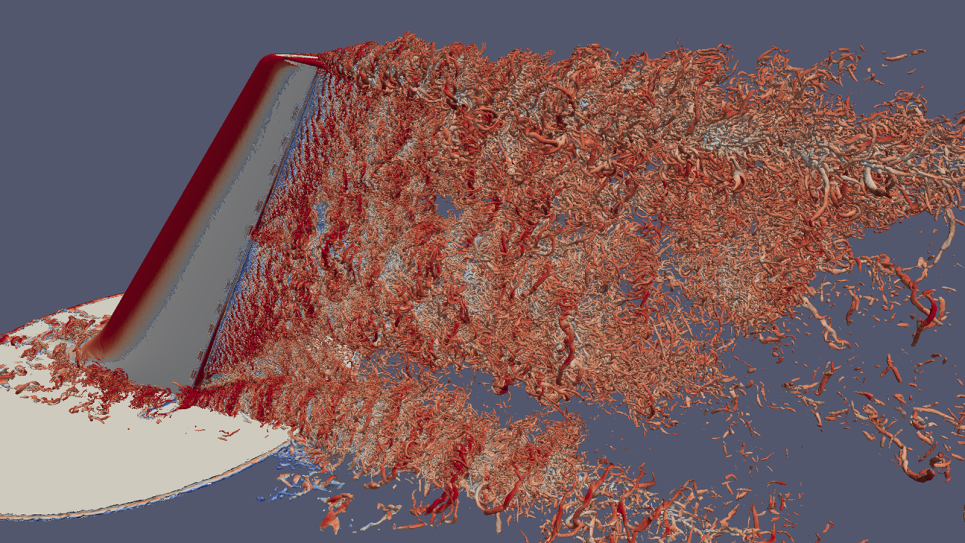
ALCF Research Aimed at Safer, Cleaner Combustion for Gas Turbines
Researchers from the Swiss Federal Institute of Technology (ETHZ) and the Argonne Leadership Computing Facility (ALCF) are using supercomputers to advance the development of safer and cleaner gas turbine engines by studying the operating conditions that can lead to a potentially dangerous phenomenon called autoignition.
This phenomenon, which involves the spontaneous ignition of a combustible mixture without an external ignition source, can result in a premature combustion event, called flashback, that causes significant damage to the gas turbine. Understanding autoignition is critical to the design of turbines that operate with novel combustion strategies, such as lean premixed (LP) and lean premixed prevaporized (LPP) combustion, to provide low emissions and high thermal efficiency.
Capable of running on hydrogen and other alternative fuels, stationary gas turbines are of interest to the U.S. Department of Energy (DOE) for their ability to produce clean, fuel-efficient, and relatively low-cost energy. LP and LPP combustion regimes will help gas turbines to meet the increasingly stringent government regulations for nitrogen oxide (NOx) emissions.
In LP and LPP turbine systems, a premixing section is located upstream of the main combustion chamber to enable fuel and air to be thoroughly mixed prior to combustion. This uniform, lean fuel-air mixture, which produces lower NOx emissions when burned, is subsequently delivered to the main combustion chamber. However, under certain conditions, unwanted autoignition can occur before the mixture reaches this chamber.
“The conditions for autoignition vary for different fuels and are determined by many factors including intensity of turbulent mixing, local chemical reactivity, operating pressure, and temperature of the incoming fuel and air streams,” said Ammar Abdilgahnie, a postdoc at the ALCF. “Understanding this process is of great importance to the design of modern fuel-flexible combustion systems that operate safely and efficiently while meeting tighter environmental regulations.”
As part of an Early Science Program (ESP) project, Abdilgahnie collaborated with ETHZ researcher Christos Frouzakis to use Mira, the ALCF’s 10-petaflops supercomputer, to study the propensity of fuel-air mixtures to autoignite in a confined jet in cross-flow configuration. Specifically, the researchers simulated a hydrogen fuel jet being injected into a turbulent hot stream of air in a channel for two cross-flow stream temperatures (930 K and 950 K) and friction Reynolds numbers (180 and 590).
The researchers used the low Mach number reactive flow solver based on the Nek5000 spectral element code to perform large-scale direct numerical simulations (DNS). Developed by Argonne computational scientist Paul Fischer, Nek5000 is a highly scalable code that is used by hundreds of researchers worldwide. For this project, Fischer assisted with development of the computational mesh and boundary conditions.
In the analysis of the simulation data, the research team also employed the Chemical Explosive Mode Analysis (CEMA) technique to evaluate the local chemical time scale, providing insight into the ignitability of the hydrogen-air mixture throughout the premixing section.
“We used the ALCF’s visualization and analysis clusters to produce visualizations and animations from the massive DNS data sets that helped us unravel the complex turbulent-chemistry interaction, autoignition spot formation and propagation, and aerodynamic stabilization mechanisms of stable flames forming behind the fuel jet,” Abdilgahnie said.
Their work resulted in the creation of DNS databases that shed new light on the complex turbulence-chemistry interaction leading to autoignition and stable flame formation. These databases offer a valuable guide for gas turbine engine designers, helping them to accurately estimate the depth of jet penetration, local rates of mixing, and the ignitability of mixtures at different operating conditions. The results also provide a highly accurate resource for the research community to validate and tune advanced turbulent combustion models.
With the ESP project wrapping up at the end of the year, Frouzakis will continue using Mira to study autoignition and flame propagation with an allocation through the DOE’s Innovative and Novel Computational Impact on Theory and Experiment (INCITE) program. The 2014 project will expand the scope of the work to focus on internal combustion engines as well as gas turbines.
“To advance the development of new combustion strategies, it is critical to have predictive models that accurately account for all of the relevant physics and chemistry interactions,” Frouzakis said. “With our work at the ALCF, we’re aiming to provide new data that will improve engineering models and enable novel concepts for next-generation combustion systems.”


